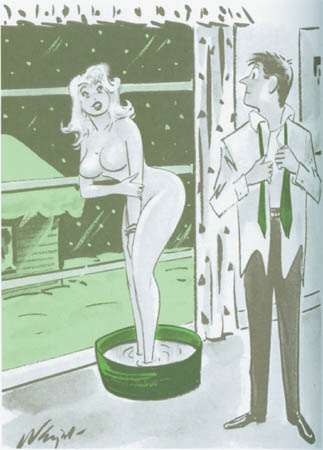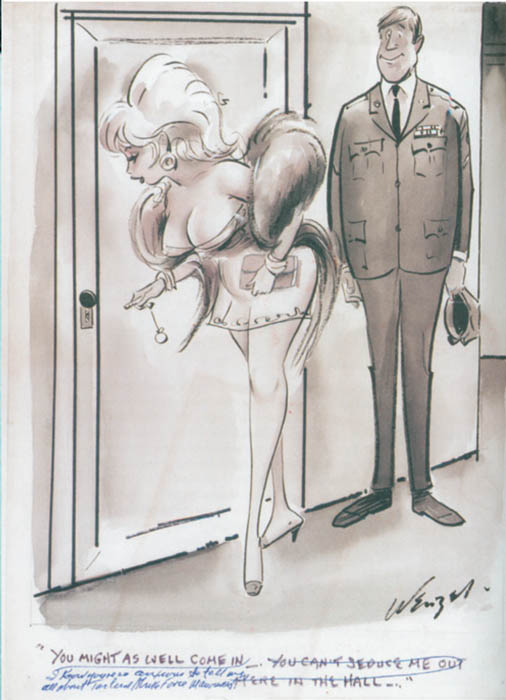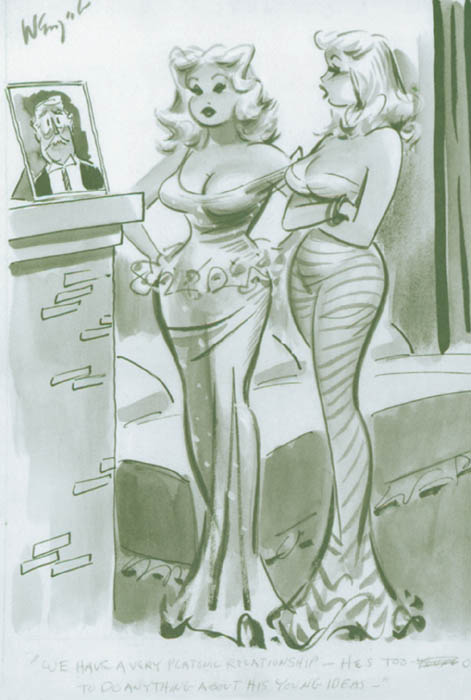
Born in 1918 to Hungarian immigrants, Bill Wenzel came from a poor, working-class family and had to struggle more than most to achieve his dream of drawing for a living. The redheaded young man was encouraged by his high school art teacher to apply to Cooper Union in NYC, and he won a scholarship—the only way he would have been able to continue his art studies.
Like many pin-up artists, Wenzel honed his craft when he was drafted into the army and became the staff artist on the camp newspaper The Palisades. There, his artwork sat alongside Milton Caniff’s Male Call strip and Wenzel’s original cartoons soon became highly prized decorations for offices of the army’s top brass. While in the army, Wenzel also worked for several civilian magazines, such as Army Laughs.
Wenzel married his Union High School sweetheart, Marion Moriarty, in 1942, and they had a daughter, Candace, two years later, followed by a second daughter, Dorian, in 1957.
Bill Wenzel’s women were very different to Ward’s, Cole’s, or even DeCarlo’s. With plumper hips, rounded stomachs, and softer curves, his Rubenesque ladies seemed more real somehow. And yet they were just as alluring as any of his contemporaries’ femmes fatales. His daughter Dorian recalled, “Some say the women in the drawings look like our mother. Dad always felt that women should have a little bit of a stomach, big hips, and a hiney.”

Miss Geewhiz, from the magazine of the same name, was quite liberated for the time.

Miss Geewhiz gives as good as she gets in this pen and ink strip by Wenzel.
Wenzel’s work graced many covers of 1940s humor digests like Romp, Fun House, and Laugh Riot, and he even flirted with sequential storytelling for a while with his Miss Geewhiz strip, the heroine from the Humorama title of the same name. Wenzel was published consistently from the 1940s in titles like Judge, right up to the fantastically named Sex to Sexty magazine of the 1960s. The cartoonist’s work was so popular it was collected into an anthology entitled Wenzel’s Wenches.
By now, printing processes had caught up with Wenzel’s talents and he switched from pen-and-ink linewashes to full-color watercolors for magazines like Escapade and cheeky kiss-and-tell paperback books like Fly Me and Coffee, Tea, or Me?
Wenzel spent the majority of his life living in New Jersey and regularly made trips to New York to see his editors and fellow cartoonists. He and Marion finally moved to Florida, where Wenzel continued to freelance until his death.

“Isn’t this kind of drastic punishment just for walking on the grass?”

The caption, “Look, George! September Morn’!” cleverly refers to a painting by Paul Chaba that caused controversy in Chicago in 1913 for its nude content.

Wenzel’s parody of the Kinsey Report. “I not only read it—I sent in 69 pages of information.”

“You might as well come in. You can’t seduce me out in the hall…”

These stunning, archetypal Wenzel women mull over their relationships: “We have a very platonic relationship—he’s too old to do anything about his young ideas.”